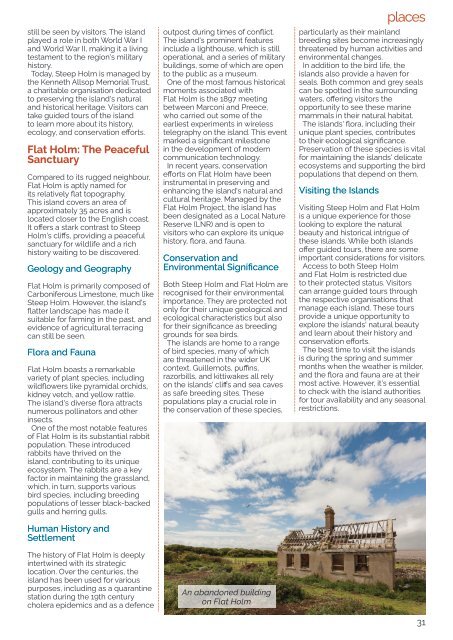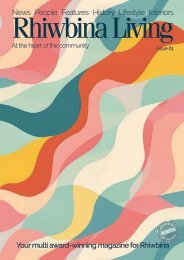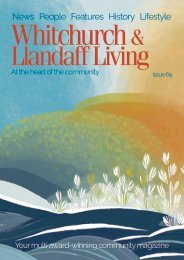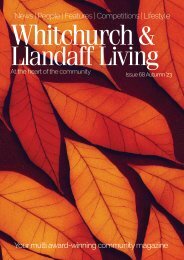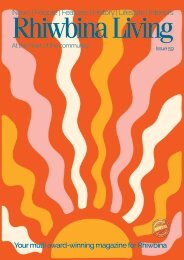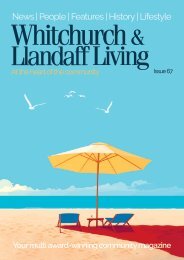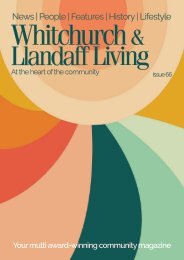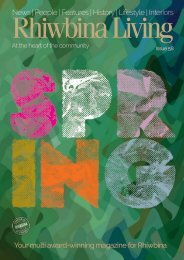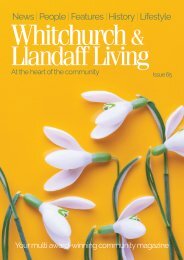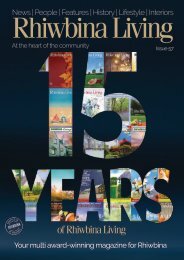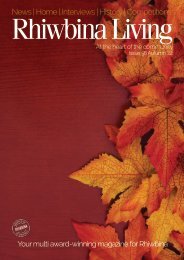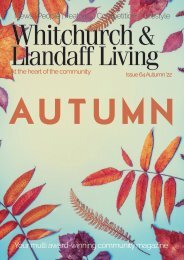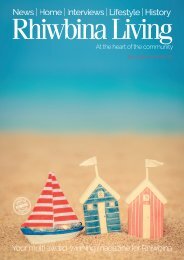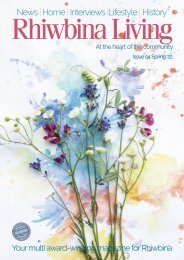Rhiwbina Living Autumn 2023
Autumn 2023 issue of Rhiwbina Living magazine.
Autumn 2023 issue of Rhiwbina Living magazine.
Create successful ePaper yourself
Turn your PDF publications into a flip-book with our unique Google optimized e-Paper software.
still be seen by visitors. The island<br />
played a role in both World War I<br />
and World War II, making it a living<br />
testament to the region's military<br />
history.<br />
Today, Steep Holm is managed by<br />
the Kenneth Allsop Memorial Trust,<br />
a charitable organisation dedicated<br />
to preserving the island's natural<br />
and historical heritage. Visitors can<br />
take guided tours of the island<br />
to learn more about its history,<br />
ecology, and conservation efforts.<br />
Flat Holm: The Peaceful<br />
Sanctuary<br />
Compared to its rugged neighbour,<br />
Flat Holm is aptly named for<br />
its relatively flat topography.<br />
This island covers an area of<br />
approximately 35 acres and is<br />
located closer to the English coast.<br />
It offers a stark contrast to Steep<br />
Holm's cliffs, providing a peaceful<br />
sanctuary for wildlife and a rich<br />
history waiting to be discovered.<br />
Geology and Geography<br />
Flat Holm is primarily composed of<br />
Carboniferous Limestone, much like<br />
Steep Holm. However, the island's<br />
flatter landscape has made it<br />
suitable for farming in the past, and<br />
evidence of agricultural terracing<br />
can still be seen.<br />
Flora and Fauna<br />
Flat Holm boasts a remarkable<br />
variety of plant species, including<br />
wildflowers like pyramidal orchids,<br />
kidney vetch, and yellow rattle.<br />
The island's diverse flora attracts<br />
numerous pollinators and other<br />
insects.<br />
One of the most notable features<br />
of Flat Holm is its substantial rabbit<br />
population. These introduced<br />
rabbits have thrived on the<br />
island, contributing to its unique<br />
ecosystem. The rabbits are a key<br />
factor in maintaining the grassland,<br />
which, in turn, supports various<br />
bird species, including breeding<br />
populations of lesser black-backed<br />
gulls and herring gulls.<br />
Human History and<br />
Settlement<br />
The history of Flat Holm is deeply<br />
intertwined with its strategic<br />
location. Over the centuries, the<br />
island has been used for various<br />
purposes, including as a quarantine<br />
station during the 19th century<br />
cholera epidemics and as a defence<br />
outpost during times of conflict.<br />
The island's prominent features<br />
include a lighthouse, which is still<br />
operational, and a series of military<br />
buildings, some of which are open<br />
to the public as a museum.<br />
One of the most famous historical<br />
moments associated with<br />
Flat Holm is the 1897 meeting<br />
between Marconi and Preece,<br />
who carried out some of the<br />
earliest experiments in wireless<br />
telegraphy on the island. This event<br />
marked a significant milestone<br />
in the development of modern<br />
communication technology.<br />
In recent years, conservation<br />
efforts on Flat Holm have been<br />
instrumental in preserving and<br />
enhancing the island's natural and<br />
cultural heritage. Managed by the<br />
Flat Holm Project, the island has<br />
been designated as a Local Nature<br />
Reserve (LNR) and is open to<br />
visitors who can explore its unique<br />
history, flora, and fauna.<br />
Conservation and<br />
Environmental Significance<br />
Both Steep Holm and Flat Holm are<br />
recognised for their environmental<br />
importance. They are protected not<br />
only for their unique geological and<br />
ecological characteristics but also<br />
for their significance as breeding<br />
grounds for sea birds.<br />
The islands are home to a range<br />
of bird species, many of which<br />
are threatened in the wider UK<br />
context. Guillemots, puffins,<br />
razorbills, and kittiwakes all rely<br />
on the islands' cliffs and sea caves<br />
as safe breeding sites. These<br />
populations play a crucial role in<br />
the conservation of these species,<br />
An abandoned building<br />
on Flat Holm<br />
particularly as their mainland<br />
breeding sites become increasingly<br />
threatened by human activities and<br />
environmental changes.<br />
In addition to the bird life, the<br />
islands also provide a haven for<br />
seals. Both common and grey seals<br />
can be spotted in the surrounding<br />
waters, offering visitors the<br />
opportunity to see these marine<br />
mammals in their natural habitat.<br />
The islands' flora, including their<br />
unique plant species, contributes<br />
to their ecological significance.<br />
Preservation of these species is vital<br />
for maintaining the islands' delicate<br />
ecosystems and supporting the bird<br />
populations that depend on them.<br />
Visiting the Islands<br />
places<br />
Visiting Steep Holm and Flat Holm<br />
is a unique experience for those<br />
looking to explore the natural<br />
beauty and historical intrigue of<br />
these islands. While both islands<br />
offer guided tours, there are some<br />
important considerations for visitors.<br />
Access to both Steep Holm<br />
and Flat Holm is restricted due<br />
to their protected status. Visitors<br />
can arrange guided tours through<br />
the respective organisations that<br />
manage each island. These tours<br />
provide a unique opportunity to<br />
explore the islands' natural beauty<br />
and learn about their history and<br />
conservation efforts.<br />
The best time to visit the islands<br />
is during the spring and summer<br />
months when the weather is milder,<br />
and the flora and fauna are at their<br />
most active. However, it's essential<br />
to check with the island authorities<br />
for tour availability and any seasonal<br />
restrictions.<br />
31


